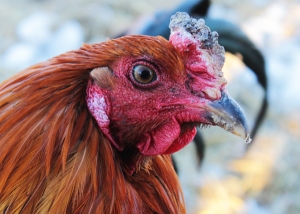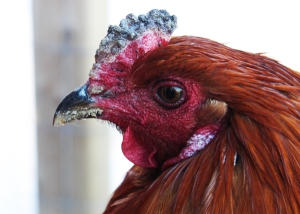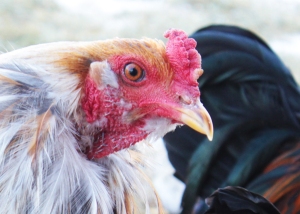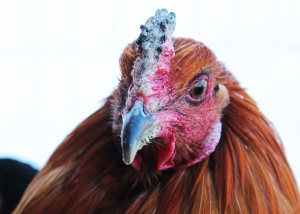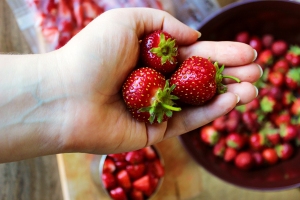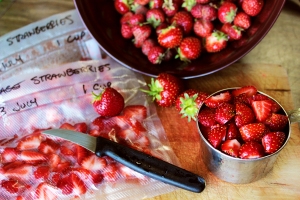Well, the cold snap in the US seems to be over, now, and our own month-long run of -30 C temperatures seems to have broken, as well. I noticed a recent spike in traffic to a few of my posts from the last couple of winters, but didn’t really draw the connection until just now…folks have been searching for information on how to manage livestock in extreme cold, but my poor visitors have mostly gotten anecdotes about me feeling sorry for myself and about frozen-solid chickens. I thought that even a belated post might be useful to somebody someday, so here are some observations about coping with extreme cold.

I’m not going to say much about dressing for the cold, since that’s been done to death on the internet. Dress in layers, and take layers off as you become warm. Make the outer layer windproof if you can. Windchill is much more dangerous than just cold, especially if you are only outside for short periods – an hour or two – Hubby routinely goes out to shovel for a couple of hours at a time in -30, as long as there’s no windchill. Of course, he’s acclimatized to this weather, and appropriately dressed, more or less. He’s never gotten frostbite, even though he doesn’t make much effort to cover his face; the moustachesicles get pretty impressive sometimes:

The chickens seem to cope pretty well with the cold, overall. Our breeds are suited to colder temperatures, but we don’t heat the coop, even when it’s -40. Our main tactic has been to insulate; our primary coop is an old shed, and we stack old bales of hay and straw around the structure to cut the wind and keep it warm. We try to get the stacks as high as the heads of the chickens on the top rung of the roost, as someone has used the shed for a target for shotgun practice, so it’s anything but airtight, and we don’t want anyone to get frostbite when they’re sleeping. You don’t actually want the coop to be totally airtight; you need some airflow to keep it from getting too humid, which will cause problems with frostbite. The birds also get a deep layer of bedding, and as much feed as they want. They eat half again as much at -40 C as they do at zero degrees or above, and they need all of that energy to keep warm. We have had some issues with frostbite in the past; Gallus, our original rooster, had a pretty spectacular comb until he encountered his first major winter freeze. We’ve since learned to keep the coop shut on really cold days, which keeps the birds inside, and also helps keep the temperature up. While I’m sure it hurt to lose that comb, it doesn’t seem to have slowed Gallus down too much.
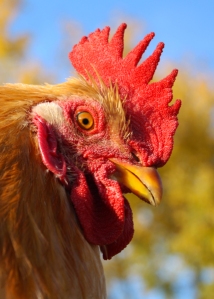
Before his first encounter with real cold
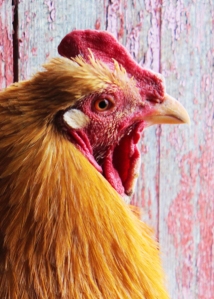
All healed up, but not much of a comb left
The frostbite itself makes the combs and wattles turn black in the frozen parts, and eventually peels off. If you come across this, you will need to monitor that the other chickens aren’t pecking at it and keeping it from healing, as it sometimes bleeds as the damaged tissue sloughs off.
One challenge is collecting the eggs before they freeze so solid that they crack, which takes no time at all in -40. The cracked eggs are okay to eat, as long as the shells are clean; we just thaw them on the kitchen counter overnight. They need to be used immediately once they’ve thawed, though, as bacteria can get in through the crack. Whatever we can’t eat ourselves, we feed to the cats and dogs, who really appreciate the extra protein. Eggs that have frozen but not cracked are fine, and we just put them in the cold room to thaw. As far as we’ve been able to tell, they keep just as well as unfrozen eggs, and behave the same when you cook with them, so we don’t even check anymore, beyond looking for the cracked ones, of course.
When it gets below about -25 C, we tend to leave the barn shut up, and the body heat from the animals adds at least ten degrees in there. The barn cats are bright enough to stay inside, and we’ve built them a cozy insulated shelter out of hay bales. So far, they’ve never had any issues with frostbite, even on their ears. However, the barn cats are outdoor critters, and acclimatized to the cold through the fall and early winter, and they know enough to snuggle up together in the shelter. Like the chickens, the cats are free-fed – we put out bowls of food, and they can have as much as they want. They put on several pounds each of fat in the fall, which helps them stay warm, too.
If we had a sudden huge drop in temperatures like happened so recently in the US, though, I would consider bringing outdoor cats and dogs inside, or locking them in a garage or barn, as they may not be equipped to deal with the cold. At the very least, they need some sort of insulated shelter, including insulation between them and the ground, that is windproof, dry, and small enough to warm up with just their body heat. Stacked bales covered with a tarp would probably do, but remember to insulate the bottom, too, either using a layer of bales, or a thick bed of straw or blankets.
The goats and alpacas mostly cope fine, as well, but again, they grow a thick coat in the fall, and we give them extra grain as it gets colder outside – the colder it is, the more hay and supplements they get. We take out warm water twice a day, and they drink their fill immediately. The buckets freeze over in a couple of hours, or less when it’s really cold. We’ve found that the goats drink more when the water is taken out warm, rather than cold, and it probably helps them maintain a good temperature. Some people say that the buckets freeze slower if you use cold water, which may be true, but for the small difference it makes in freezing time, we go with the warm, especially because the goats drink so much more when we take the warm water out. I have heard of people putting sweaters on their goats, which is probably a good idea in a sudden cold snap; we’ve never done it because we worry they would lose their winter coats.
If you are milking in winter, make sure the udder, and especially the teats, are completely dry when you are done. We minimize trimming the udder as much as possible, and leave some fur, especially on the back, even when we do trim. I just brush the furry parts of the udder thoroughly with a soft brush before milking to make sure there’s no crud falling into my milk bucket. I take a towel out with me to dry everyone off after milking. However, since I’m not fond of milking -30, we’ve taken to drying the girls off by late November. While this doesn’t maximize our milk production, it does minimize everyone’s discomfort. We freeze milk and make (and freeze) lots of cheese in the summer, to tide us over.
Our biggest issues with the goats has been with kidding during cold snaps. Our first year, we were kidding in March, and at least four kids came when the temperatures were below -20. All of those kids got frozen ears, and two lost part or all of their ears.

Poor Luna lost her ears to freezing at birth.
We’ve since started breeding for kidding in late April or later; this year’s kids will come in mid-May. I know of breeders with unheated barns who treat kids like day-old chicks; they confine them using straw bales, and hang a heat lamp overtop. Other breeders keep their kids indoors in playpens for the first couple of weeks. Either tactic works fairly well if you are bottle feeding, but not if you’re dam-raising your kids. We’ve learned to keep the pregnant does confined for the last few weeks of their pregnancy, and we do our best to keep the maternity stall well-insulated and draft-free. The kids are most vulnerable to freezing just after birth when they are wet, so it’s important to make sure they are dried off quickly, which has involved us ‘helping out’ with towels when momma wasn’t working fast enough. When they are cold, kids tend to stand all hunched up with their back arched, and look really miserable. If we see that going on for any length of time in cold weather, we bring the kids into the house periodically for ‘warm-up’ sessions, and take them back out to their dams every couple of hours to eat.
We’ve had kids collapse from cold before; if you’re quick, they can recover without issue, but you need to get them warm, fast. We’ve used 2L plastic juice bottles filled with hot water from the tap, wrapped in towels and tucked around the kid. Remember, too, that kids need extra food when it’s cold, and make sure your does are producing enough, and/or you add a bit extra to the bottles if they’re living in an unheated barn.
Cold is not bad if you are prepared for it, but I can imagine it would be awfully miserable if you didn’t have, and couldn’t get, appropriate clothing and supplies. I know some of my American friends really struggled. Hopefully everyone has come through okay, and is at least starting to warm up now!
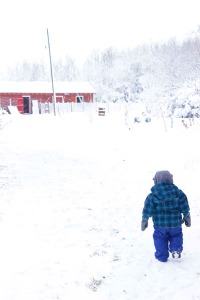
Read Full Post »
